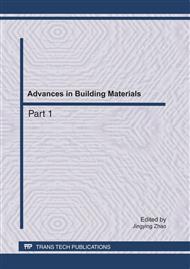p.761
p.765
p.770
p.775
p.783
p.788
p.796
p.801
p.807
Thermal Insulation Property of Newspaper Membrane Encased Soil-Based Aerated Lightweight Concrete Panels
Abstract:
Roof and wall are known to be responsible for heat entering into a building and should therefore be thermally insulated in order to lessen energy consumption required for air-conditioning. In this study, four soil-based aerated lightweight concrete (ALC) panels each measures 750 mm (length) x 750 mm (breadth) x 70 mm (thick) with different aerial intensity of newspaper membrane encased were produced and tested on their thermal insulation property. For environmental friendly and economy reasons, clayey soil was used in place of sand to produce the ALC panels and they were tested in the Thermal Laboratory for twenty hours. Temperature gradient was computed based on the surface temperature measured during the test. The results obtained indicated that newspaper membrane encased soil-based ALC panels have superior heat insulation performance compared to control panel in terms of temperature gradient. It is found that the temperature gradient increased from 1.92 °C/cm to 2.08 °C/cm or 8.3% higher than control panel with just merely 0.05 g/cm2 of newspaper membrane encased.
Info:
Periodical:
Pages:
783-787
Citation:
Online since:
May 2011
Authors:
Price:
Сopyright:
© 2011 Trans Tech Publications Ltd. All Rights Reserved
Share:
Citation:


